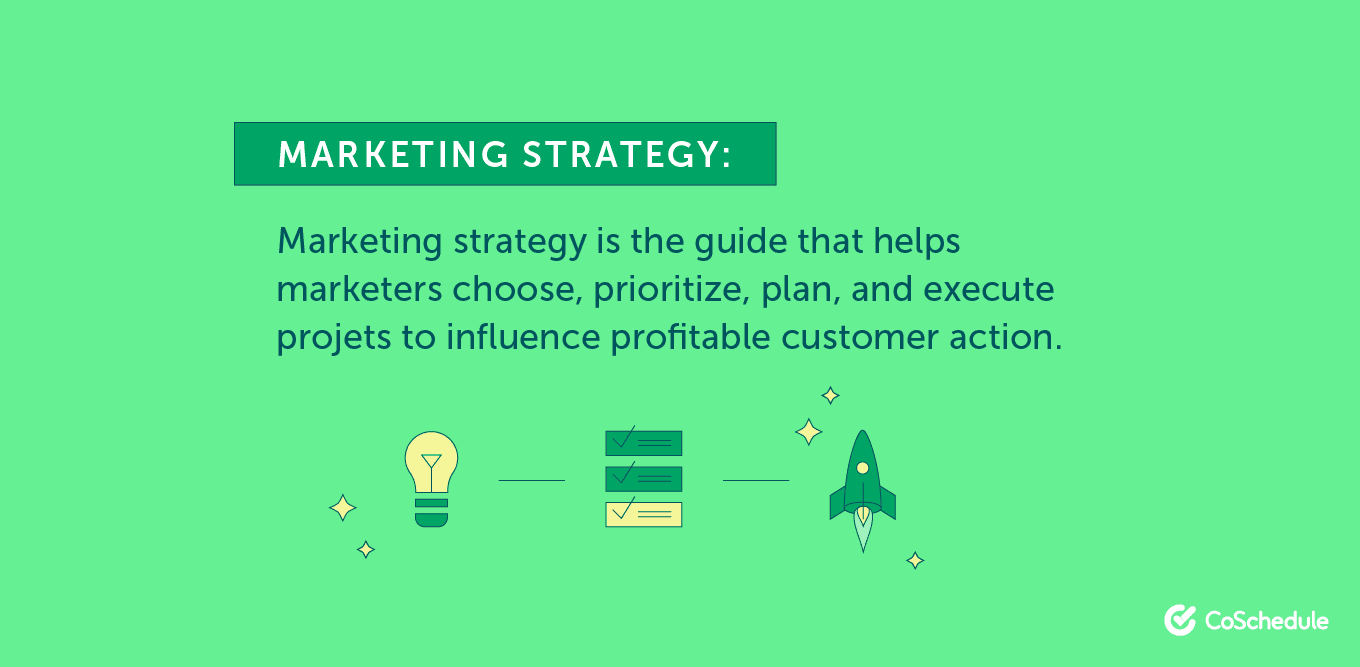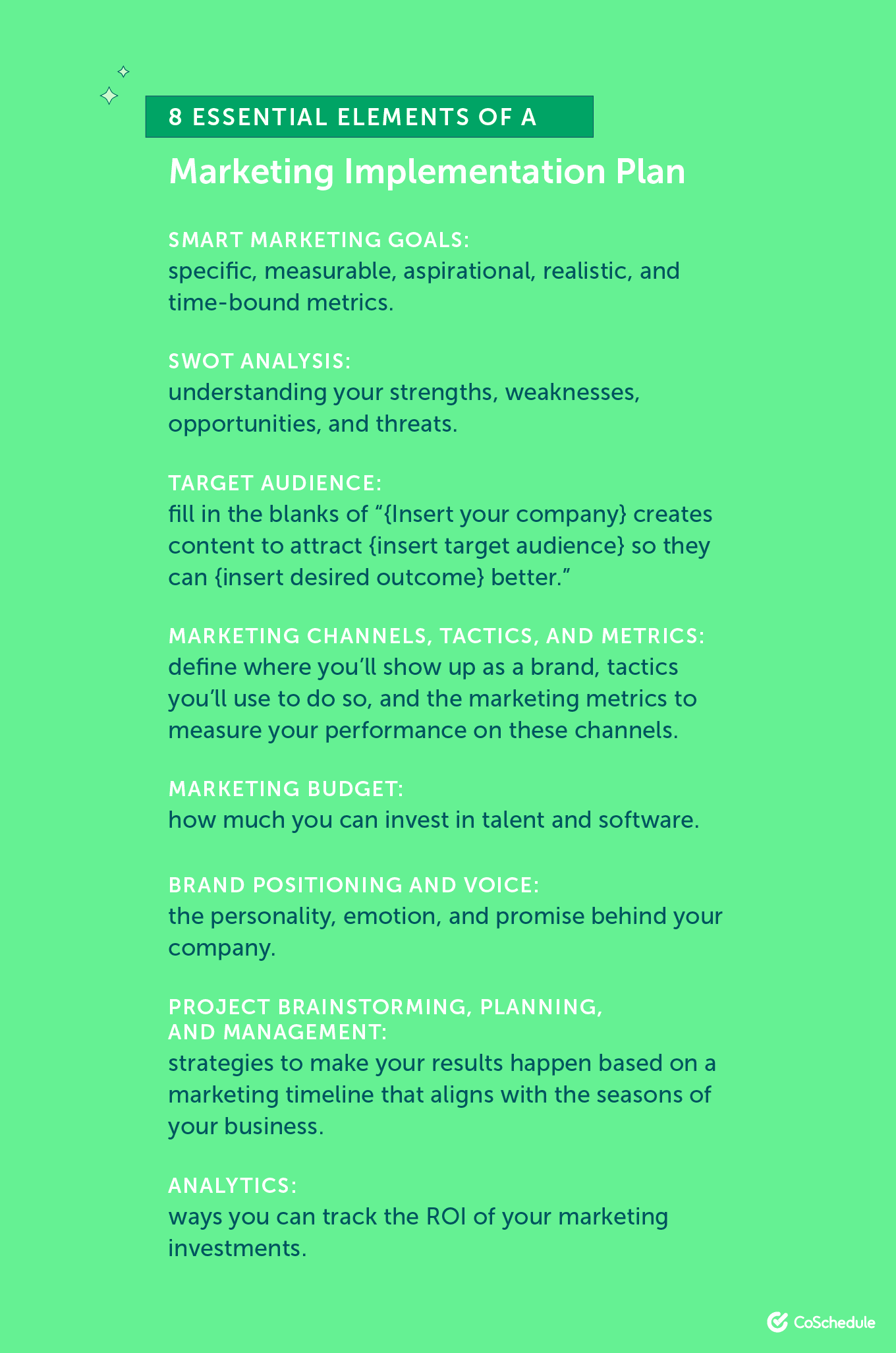Marketing Implementation: Put Your Strategy Into Practice (With a Template)
 Setting goals for your marketing team is one of the most powerful actions you can take. After all, one study after another has shown that goal setting is linked to higher achievement.
But setting goals isn’t enough—all of us who’ve missed them at least once can vouch for that.
Your reason to miss a marketing goal doesn’t have to be huge. Take these examples:
Setting goals for your marketing team is one of the most powerful actions you can take. After all, one study after another has shown that goal setting is linked to higher achievement.
But setting goals isn’t enough—all of us who’ve missed them at least once can vouch for that.
Your reason to miss a marketing goal doesn’t have to be huge. Take these examples:
- Someone dropped the ball on a project because task ownership was unclear.
- A piece of software didn’t have certain features that were needed for a project.
- There simply wasn’t enough time.
- Ensure you have everything you can possibly need (including time!) to execute every marketing project and hit every goal.
- Clarify the role of each team member in your marketing workflows, including task ownership and dependencies.
- Use a project management style that will help you consistently iterate and upgrade your process, as well as scale and grow when the time comes.
Marketing Implementation: How to Put Your Strategy Into Practice With a Template by @MarijanaKay via @CoSchedule
Click To TweetWhat is Marketing Implementation?
Marketing implementation is the process of turning your marketing strategy into real-life actions: tasks and projects, people responsible for them, and deadlines. In other words, it’s about bringing your marketing plan to life. Instead of living on paper, it starts living on a day-to-day calendar because it’s translated into action. According to Statista, 71% of marketing professionals believe their marketing strategy is effective. While that sounds promising, it still leaves almost a third of marketers feeling unsuccessful. With marketing implementation, it becomes a lot easier to identify if the issue is with the way a strategy is executed, or with the strategy itself.
What Are the Benefits of a Marketing Implementation Plan?
If there’s a marketing strategy document somewhere in your drawer or your hard drive, you may feel that that’s more than enough to keep your team going. Sounds like you? Consider these questions:- Does everyone know what to work on at any time?
- Do they know how long they should be working on each task?
- Are they aware of how a single task impacts the big picture, or are they just checking something off their list because it’s there?
It Makes Expectations Around Deadlines Clear
A survey of CoSchedule’s email and social media audience of marketers revealed a huge insight: 65% of marketers don’t use marketing project management software. On top of that, 69% don’t include a dedicated marketing project manager. Without a tool or a person to tell you when things need to get done by, it’s easy to let tasks slip. This is particularly the case with projects that aren’t urgent or that might take a while to yield huge results (for example, content marketing). It’s easy to keep pushing them back and get distracted with things that seem more urgent. With a marketing implementation plan, marketing strategies become real-world actions that need to happen by a certain date in order to work.It Builds Accountability Through Task Ownership
“I thought you were supposed to do that.”Possibly the most dreaded eight words for any team, ever. Things get done when they exist on a specific to-do list. They definitely don’t get done when they only exist in a marketing strategy document. With a marketing implementation plan, goals and projects are broken down into workflows and individual tasks. Then, as tasks get assigned, their owners know how their work impacts everyone else’s work.
 In other words, they know if they don’t do their part, the whole project could fall behind, and marketing goals will be missed.
In other words, they know if they don’t do their part, the whole project could fall behind, and marketing goals will be missed.
It Gives Your Team a Roadmap to Follow For Getting Things Done
Let’s talk about that marketing strategy document again. Is it readily accessible for your whole team? Is it easy to understand and put into practice? And if we presume it’s 30 pages long, does everyone on your team know exactly where to find guidance for their next actions? A marketing implementation plan takes your long-term plans and turns them into clear processes. And if you tend to stress about efficiency and deadlines, you’ll love planning in sprints as part of agile marketing, which we’ll cover in a later section. These clear processes happen in the form of:- Marketing workflows
- Task templates and checklists
- Marketing kanban boards
It Ultimately Makes the Plan You’ve Crafted a Reality
Ever reached the end of a quarter or a year and wondered how so many of the things you wanted to do never happened? Maybe you wanted to test a new approach to social ads, or increase your focus on visual content. Maybe you hoped to double down on email marketing, or promote your company’s podcast better. Somehow, all the meetings, emails, admin, reporting, and simply keeping up with your day-to-day work got in the way of it. With the six steps outlined below, you’ll never fall behind on your marketing projects and goal again.Develop and Execute a Marketing Implementation Plan in 6 Easy Steps
Here are the exact steps you can take to make your marketing strategy a reality—and a successful one!Step 1: Set Accurate Expectations For How Quickly Things Can Get Done
The first step is to manage everyone’s expectations, including your stakeholders, your team, and yourself. This will remove unwanted pressure and create space for experiments and iterations. If you planted a tree today, would you have a tree tomorrow? Take that approach when implementing your marketing plan, too. Building an audience, generating demand, and gaining momentum all take time. Results take time, especially when you consider that results come in the form of traffic, social shares, leads, sales conversations, webinar attendees, revenue, and more. Therefore, it’s up to you to figure out just how much time your results will likely take. Depending on who you ask, the answer to the “how long does content marketing take to work?” question is anywhere between 6 and 18 months. The more honed in your marketing plan is (including your goals, audience, messaging, and more), the more accurate your predictions will be.Step 2: Determine Which Resources Will Be Needed to Execute the Plan
Your marketing plan is unique to you. It focuses on products or features you’re launching, metrics you want to hit, revenue you want to win. Based on that focus, identify the resources that will help you get there, including talent and software. For talent, you may look for:- Content creation skills: blog posts, website content, landing page copy, social media posts.
- Graphic design: creation of visuals like charts, infographics, and more.
- Technical skills: understanding of SEO and its technical foundations, custom elements for your website, and more.
- Social media management: scheduling regular content, managing comments and replies, understanding specifics of each platform.
- Project management: keeping projects on track.
- In-house marketing team: there’s no single way to structure a marketing team, so simply make sure you’re covering all of your long-term bases, such as writing and design, and expand over time.
- External agencies and consultants: specialized projects and campaigns may be better executed with a temporary external hire. For example, you may build a set of animations or infographics by temporarily working with a specialist.
- Marketing project planning and management (like CoSchedule’s Marketing Suite)
- Content management system
- Social media management
- Email marketing
- Social listening
- Search engine optimization
- Video hosting
- Landing pages
- Marketing automation
- Analytics
Step 3: Document a Marketing Strategy
CoSchedule’s survey revealed that only 16% of marketers have their entire marketing strategy documented. Others either have portions of the strategy documented, or none. This feels like a great point to remind you that marketing isn’t about producing content; it’s about producing content that brings results. A powerful marketing strategy results in profitable customer action—profitable being the key word. A well-defined marketing strategy targets the right audience with the right content, at the right time, and with the right level of effort.
Building a marketing strategy is such an important process that CoSchedule has built a 15-chapter ultimate guide showing you exactly how to do it. If you haven’t created your marketing strategy yet, use the guide to help you.
And if you have, these are your cliff notes to help you document it.
You’ll fuel your marketing implementation plan by defining and documenting the following:
A well-defined marketing strategy targets the right audience with the right content, at the right time, and with the right level of effort.
Building a marketing strategy is such an important process that CoSchedule has built a 15-chapter ultimate guide showing you exactly how to do it. If you haven’t created your marketing strategy yet, use the guide to help you.
And if you have, these are your cliff notes to help you document it.
You’ll fuel your marketing implementation plan by defining and documenting the following:
- SMART marketing goals: specific, measurable, aspirational, realistic, and time-bound metrics.
- SWOT analysis: understanding your strengths, weaknesses, opportunities, and threats.
- Target audience: fill in the blanks of “{Insert your company} creates content to attract {insert target audience} so they can {insert desired outcome} better.”
- Marketing channels, tactics, and metrics: define where you’ll show up as a brand, tactics you’ll use to do so, and the marketing metrics to measure your performance on these channels.
- Marketing budget: how much you can invest in talent and software.
- Brand positioning and voice: the personality, emotion, and promise behind your company.
- Project brainstorming, planning, and management: strategies to make your results happen based on a marketing timeline that aligns with the seasons of your business.
- Analytics: ways you can track the ROI of your marketing investments.

Step 4: Build a Workflow For Executing Each Piece of Content
At this point, you have a really strong foundation. It’s time to turn your strategy into tasks that can be placed on specific people’s calendars. How? By developing workflows for every type of content you’ll create. There are 8 steps to building effective marketing workflows. For each type of content you create, do the following:- Map out everything that needs to be done.
- Reduce the number of steps in your workflow (for example, those that used to be useful but aren’t anymore, or that fall into other processes and will happen regardless).
- Combine steps into tasks with clear action verbs.
- Give each task a clear definition of done.
- Choose who will complete each task.
- Determine how long it takes to complete each task.
- Plan how many days before publishing the task needs to be done.
- Delegate by notifying, reminding, and collaborating with task owners.
 And on a calendar, it will look like this:
And on a calendar, it will look like this:

Step 5: Have a Plan For How You’ll Manage Projects
With a step-by-step map for every campaign and content format, you need a plan to keep your projects on track. On top of that, this plan should also help you:- Embrace innovation. For example, if there’s new data showing you need to update your messaging, how can you implement it without the entire project falling apart?
- Fuel efficiency. Are you only working on high-value projects and tasks instead of getting distracted by small, 10% projects?
- Scale and grow. As your marketing team and/or external contributors grow in size, your results grow with them, and projects still get done efficiently.
 They plan these sprints ahead of time and use daily stand-up meetings to stay on track. After the sprint is over, they review it and look for ways to improve next sprints.
Still not sold on agile marketing? Consider this: marketers using agile project management are 252% more likely to report success.
Want to give it a try? Use CoSchedule’s agile marketing guide to make it happen.
They plan these sprints ahead of time and use daily stand-up meetings to stay on track. After the sprint is over, they review it and look for ways to improve next sprints.
Still not sold on agile marketing? Consider this: marketers using agile project management are 252% more likely to report success.
Want to give it a try? Use CoSchedule’s agile marketing guide to make it happen.
Step 6: Measure Your Results
As you keep executing your marketing implementation plan, it’s useful to occasionally pause and look at how your team is doing. This will allow you to review your marketing strategy and adjust your implementation plan. Here are some useful questions to answer when measuring your marketing implementation results:- Are your marketing projects yielding results in the timeframe you’ve set expectations for? Does the timeline need adjustments?
- Does your team still cover all the skills you need? Do you need to hire internally or outsource a certain project or process?
- Is your software stack still the best one for the work you want your team to accomplish?
- Is your team still relying on your marketing strategy? Is there something in your marketing strategy that isn’t working and needs to be refreshed?
- Are the steps in all your workflows still effective? Do they need to be revised?
- Does your project management strategy work for you and your team?
- How does your team feel about the process and do they have suggestions and actionable feedback?


